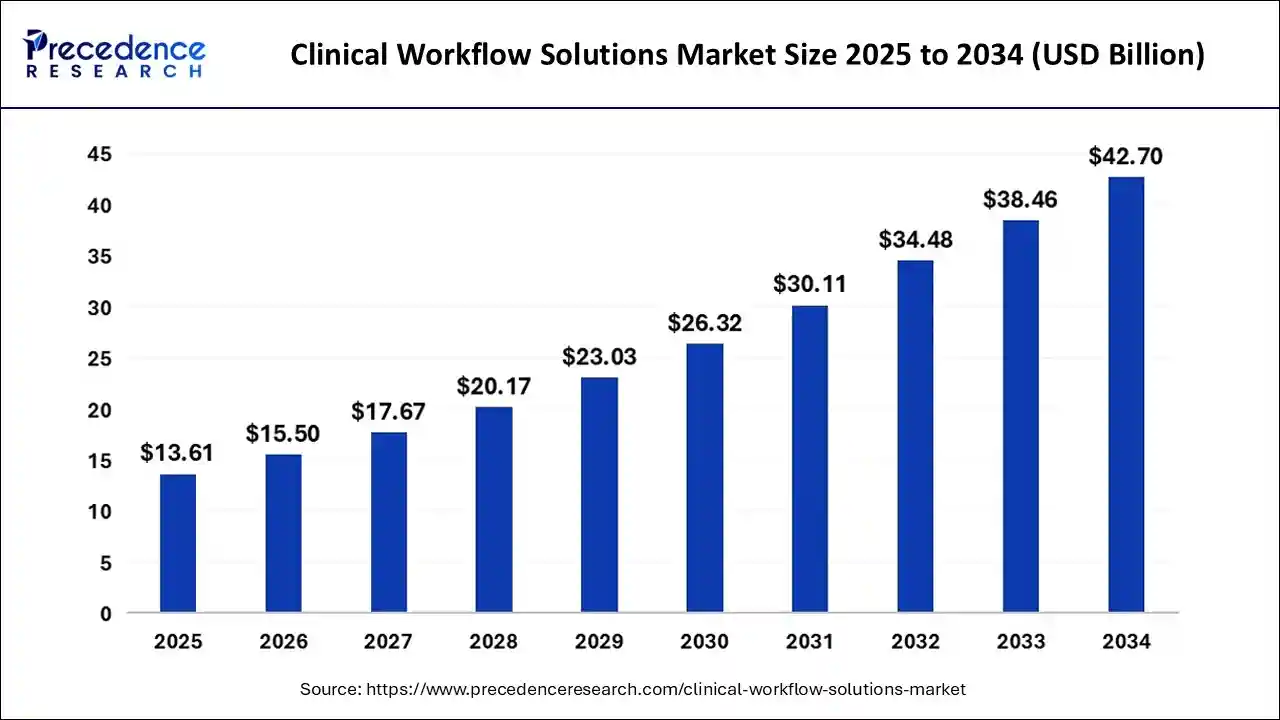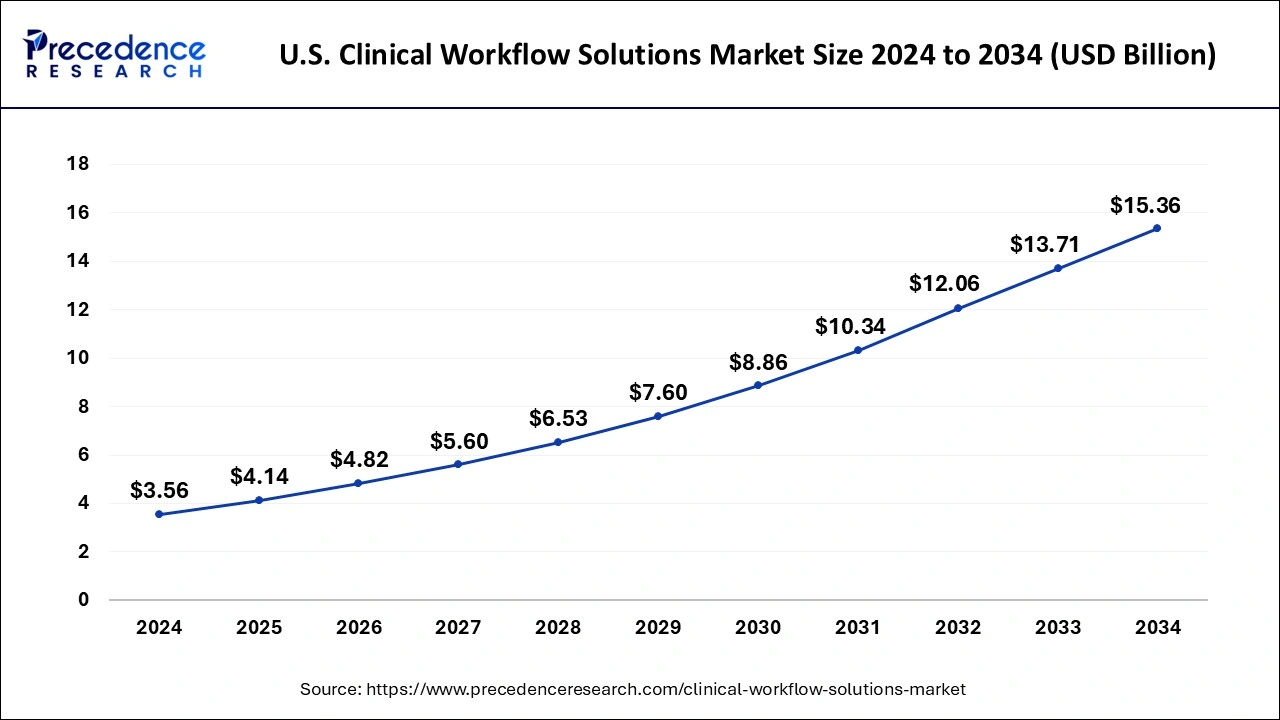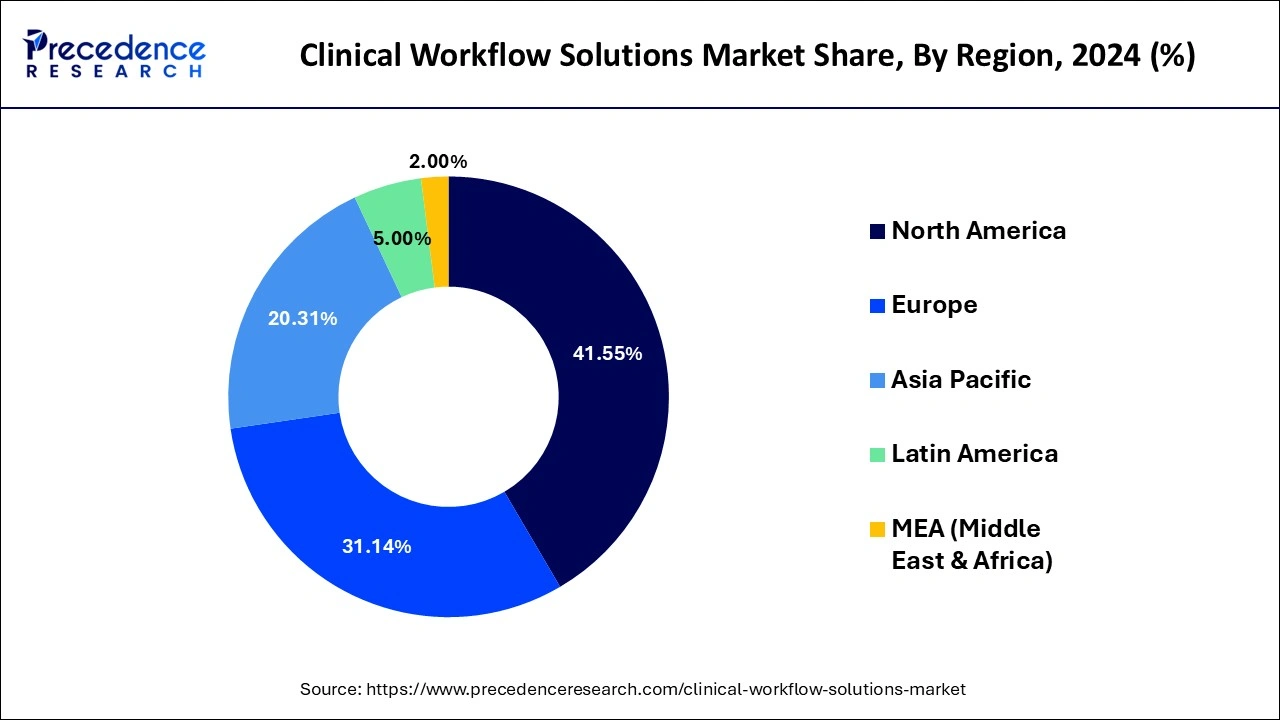List of Contents
What is the Clinical Workflow Solutions Market Size?
The global clinical workflow solutions market size is valued at USD 13.61 billion in 2025 and is predicted to increase from USD 15.50 billion in 2026 to approximately USD 42.7 billion by 2034, representing a healthy CAGR of 13.57% between 2025 and 2034. The market is experiencing significant growth due to the increasing focus of healthcare organizations on streamlining operations and reducing costs.

Clinical Workflow Solutions Market Key Takeaways
- North America dominated the market and contributed more than 41.55% of revenue share in 2024.
- By type, the data integration solutions segment accounted revenue share of over 26.4% in 2024.
- By end-use, the hospitals segment accounted for the largest market share of 46% in 2024.
Integration of Artificial Intelligence (AI) in Clinical Workflow Solutions
The integration of AI algorithms in clinical workflow solutions transforms the delivery of health care. AI technologies can help streamline processes, improve patient outcomes, and reduce errors. AI and machine learning (ML) together offer predictive analytics. This allows vast amounts of data to be analyzed to identify trends and predict outcomes. AI technologies help healthcare professionals understand the situation and variables to make an informed decision about treatment options. Utilizing AI and ML models helps improve operational efficiency by automating various tasks. They analyze patient data and help categorize the patients into risk groups, helping professionals create a more targeted and personalized treatment plan.
AI and ML technologies also help forecast the admission rates of patients, further optimizing the management of hospital resources and schedules for staff. Advanced AI algorithms like natural language processing (NLP) benefit clinical workflow solutions. It assists in clinical decision support, documentation automation, patient communication, and even voice recognition. With AI technology, the efficiency and effectiveness of clinical workflow solutions can be optimized. Thus, integrating AI technologies is anticipated to boost the growth of the clinical workflow solutions market over the forecast period.
Market Overview
Clinical workflow solutions involve various tools, software, and technologies that are designed to streamline and optimize various operations of healthcare organizations. These solutions help coordinate better between medical practitioners, staff, and patients. Analytic and communication solutions are mostly utilized solutions for effective monitoring and coordination. Adopting clinical workflow solutions helps staff and patients by enhancing communication and transparency in operations. Managing and storing vast amounts of data becomes a hassle for healthcare facilities, boosting the demand for clinical workflow solutions to manage this load and reduce the burden on healthcare professionals. These solutions help with the proper management of healthcare data. The growing need for standardization of clinical workflow further boosts the market growth.
Flowing Care: Clinical Workflow Solutions
Market Outlook
- Industry Overview: The industry includes enterprise EHR vendors building native workflow modules, point-solution vendors specializing in niche workflow problems e.g., OR optimization, e-prescribing, bed management), systems integrators, RPA and automation firms, and consulting practices that drive clinical redesign. Hospitals and health systems often combine internal process-improvement teams with vendor tools to redesign care pathways.
- Key success factors are deep clinical domain expertise, human-centred UX design for clinicians, robust analytics to measure impact, and strong implementation services that include training, change management, and post-live optimization. Competitive differentiation increasingly comes from proven clinical content order sets, pathways, seamless interoperability with devices and labs, and demonstrated reductions in clinician time burdens.
- Sustainability Trend: Sustainability in clinical workflows addresses environmental, operational, and human dimensions. Environmentally, workflow digitization reduces paper use and unnecessary patient travel via telehealth, cutting operational emissions. Operational sustainability focuses on resource efficiency optimizing staffing levels to avoid overtime, better utilization of ORs and imaging suites, and reducing redundant testing through clinical decision support.
- Social sustainability centres on clinician well-being, eliminating low-value administrative tasks to reduce burnout and turnover. Sustainable procurement also means selecting vendors with low-carbon hosting options and long-term support commitments that prevent frequent forklift replacements of software. Health systems increasingly evaluate workflow investments on both cost and human-capital sustainability metrics.
- Major Investment Themes: Investors are focused on platforms that show clear, measurable improvements in throughput, cost per case, and clinician time-savings. Hot investment themes include interoperability middleware that simplifies EHR integrations; AI-driven scheduling and capacity optimization; automation (RPA) for prior authorizations, clinical reconciliation, and billing; clinical decision support that reduces unnecessary imaging and test ordering; tele-triage and digital front-door solutions that route patients efficiently; and workforce optimization tools that reduce reliance on agency staff.
- Sustainable Ecosystems and Startups: Sustainable clinical workflow ecosystems combine vendor platforms, hospital process-improvement teams, clinician champions, and implementation partners. Startups often succeed by solving a single high-value pain point, e.g., OR turn-time optimization, e-prescription reconciliation, discharge-planning automation and then integrating into broader stacks. Accelerators tied to health systems, outcome-based pilot funding, and shared testbeds enable startups to validate efficacy and scale. Partnerships between workflow startups and staffing firms, device vendors, or telehealth platforms create bundled offerings that address both technology and operational change, making sustainable adoption more likely.
Clinical Workflow Solutions Market Growth Factors
- The rapid expansion of healthcare facilities, especially in emerging countries, is a major factor boosting the growth of the market.
- The increasing need to eliminate repetitive tasks, such as documentation, and enhance communication between various departments of hospitals further boosts the adoption of clinical workflow solutions.
- An increase in demand for patient-centered care delivery and improved clinician productivity contribute to market expansion.
- The rising adoption of electronic health records (EHRs) is expected to boost the adoption of clinical workflow solutions for improving data management.
- The growing focus on improving operational efficiency influences the market.
Market Scope
| Report Coverage | Details |
| Market Size in 2025 | USD 13.61 Billion |
| Market Size in 2026 | USD 15.50 billion |
| Market Size by 2034 | USD 42.7 Billion |
| Growth Rate from 2025 to 2034 | CAGR of 13.57% |
| Largest Market | North America |
| Fastest Growing Market | Asia Pacific |
| Base Year | 2024 |
| Forecast Period | 2025 to 2034 |
| Segments Covered | Type, End User, Region |
| Regions Covered | North America, Europe, Asia-Pacific, Latin America, and Middle East & Africa |
Market Dynamics
Drivers
Surge in demand for big data analytics
Organizations are experiencing numerous challenges in dealing with fast growing data sources as their client base grows and they expand into new regions and markets. Organizations have begun to see the benefits of fully utilizing big data and are investing in big data technologies, including clinical workflow solutions, as a result of the introduction of big data technology. Thus, surge in demand for big data analytics is driving the growth of clinical workflow solutions market during the forecast period.
Restraints
Lack of expertise
Organizations should use modern clinical workflow solutions in data management and business management these days to gather and integrate huge amounts of data from multiple internal and external data sources to gain significant business insights. However, a lack of knowledge and skills within the workforce prevents them from embracing clinical workflow solutions. As a result, the lack of expertise is hampering the growth of clinical workflow solutions market during the forecast period.
Opportunities
Benefits of clinical workflow solutions
Healthcare businesses seeking more attractive, smooth, and impactful ways to improve patient outcomes and safety are increasingly turning to clinical workflow solutions. This is due to the fact that these solutions allow for the continuous flow of real-time health data, resulting in better-informed care decisions and results. Clinical workflow solutions provide characteristics that can help enhance care quality, care coordination, and overall patient happiness while also lowering the risk of medication errors and adverse drug events, and their usage is projected to rise in the future years.
Challenges
Lack of trained professionals
The scarcity of qualified personnel is a key impediment to the implementation of IT systems in hospitals. Healthcare organizations and vendors are finding it challenging to attract competent personnel as the number of healthcare IT initiatives grows. The demand for healthcare IT specialists is currently significantly exceeding supply, not just in developing nations but also in developed areas such as the U.S. and Europe. Thus, the lack of trained professionals is a huge challenge for the market growth.
Type Insights
The data integration solutions segment accounted revenue share of over 26.4% in 2024. Data integration systems are prominently preferred by the healthcare service providers due to need for integration to curb the rising costs and increasing data volumes. Hospitals and other form of caregivers are actively adopting integrated systems that enable customers to access the patient's information during the course of their care service. This drove the market growth for data integration systems in the year 2023. Factors such as regulatory reforms & requirements, interoperability solutions, raised adoption of electronic medical records, and shifting focus towards value-based services have propelled the growth of the segment.
Care collaboration solution have gained significant traction in the past few years and expected to exhibit escalating demand during the forecast period. This is attributed to the increased emphasis on the patient-centric services. Rising number of patients across the globe also influence market players to develop more effective and efficient solutions. Care management solution provides effective workflow methodologies as well as improves patient care that save both cost and time.
End-use Insights
Hospitals occupied the maximum clinical workflow solutions market value share of 46% in the year 2024 due to rising number of healthcare facilities along with associated data that require effective management and privacy. In addition, supportive initiatives undertaken by the governments of various regions to simplify and enhance the data handling capacity in the healthcare sectors anticipated to boost the market growth of the segment. For example, as per the statistics declared by the Healthcare Information and Management Systems Society (HIMSS) in the year 2019, more than 60% hospitals have adopted EHR technology. Furthermore, the West Health Institute (WHI) declared that rising adoption of interoperability solutions can result in prominent reduction in the healthcare spending in the United States.
Additionally, ongoing trend for connected hospitals and effective management solutions anticipated to fuel the market growth over the analysis period. The rising demand for unified critical clinical communications, integrated & collaborative care delivery, and streamlined process for call scheduling are some of the key factors that contribute significantly towards the high revenue share of the segment.
On the other hand, ambulatory care centers predicted to register the highest growth over the analysis period. This is mainly due to a spike in the out-patient admissions in health centers. Integration of IT-based solutions in ambulatory care centers notably reduces medical errors as well as enhances communication among pharmacies, physicians, nursing staff, and patient's family.
Regional Insights
U.S. Clinical Workflow Solutions Market Size and Growth 2025 To 2034
The U.S. clinical workflow solutions market size is accounted for USD 4.14 billion in 2025 and is expected to reach USD 15.36 billion by 2034, growing at a CAGR of 16.16% from 2025 to 2034.

North America accounted for 41.55% market share in 2024 owing to increasing number of research & development activities on healthcare solutions along with rising number of patient admissions in the hospitals that triggers the volume of data generated expected to impel the market growth. Further, increased spending on healthcare digitization to secure the exchange of information within organizations notably supports the growth of clinical workflow solution in the region.
The rising number of incidents related to trauma injuries leads to an increased number of patients in emergency wards, boosting the demand for care collaboration solutions. Governments of various countries in North America are implementing policies to promote clinical workflow solutions. This, in turn, increases the adoption of clinical workflow solutions in healthcare facilities across the region. The region is at the forefront of healthcare technologies, leading to the rapid development of advanced clinical workflow solutions in North America.

Besides this, the Asia Pacific registered the fastest CAGR of 14% over the forecast period owing to prominent surge in the demand for healthcare IT solutions in the medical sector. Further, government support for increasing medical tourism, implementing e-Health, high demand for quality healthcare, and improving healthcare infrastructure are the important factors that supports the market growth in the region.
With the rising consumer disposable income, healthcare expenditure is rising. The rising population growth in countries like India and China significantly increases the patient pool, making it challenging for healthcare facilities to manage the patient pool efficiently. Governments of Asian countries are also investing heavily in expanding healthcare facilities in rural areas. In addition, with the increasing digitization, there is a high adoption of advanced technologies in the healthcare sector, boosting the market growth in Asia Pacific.
Can Latin America Close Care Gaps with Smarter Workflows?
Latin America's healthcare systems face uneven IT maturity: large urban hospitals often run sophisticated EHRs and can adopt advanced workflow optimisation tools, whereas smaller clinics and rural hospitals may lack basic digital records. Clinical workflow solutions that emphasize low-bandwidth operation, mobile-first interfaces, and strong localisation language, regulatory forms are best suited for the region.
High-impact, low-complexity modules appointment scheduling, tele-triage, task management, and discharge-planning automation can deliver quick wins by reducing wait times and improving bed turnover. Partnerships with regional integrators, outcome-based pilot funding, and training programs for clinical staff help ensure sustainable adoption across diverse country contexts.
Will MEA Leapfrog with Cloud-First, Mobile-Centric Clinical Workflows?
The Middle East & Africa region contains pockets of high-tech healthcare Gulf states, private centres alongside resource-constrained public systems. Cloud-first, mobile-centric workflow solutions that lower infrastructure costs, enable remote specialist support, and streamline administrative tasks are particularly compelling. In wealthier markets, comprehensive enterprise optimisations OR scheduling, integrated clinical decision support are viable, while in lower-resource settings, pragmatic tools offline-capable scheduling, SMS-based patient reminders, and lightweight tele-triage, deliver the most value.
Financing models managed services, outcome-based contracts, and vendor-led training Strong local partnerships are key to overcoming supply-chain and talent constraints and achieving sustained improvements in clinical efficiency.
Market Chain Value Analysis
- Raw Material Sourcing: In a software-led market the raw materials are cloud infrastructure, secure identity and access management services, clinical content libraries validated order sets, pathways, integration components APIs, HL7/FHIR connectors, and human expertise clinical informaticists, implementation engineers, validation specialists.
- Technological Advancements: Advances shaping the market include FHIR-based interoperability that streamlines data exchange; AI/ML for predictive capacity planning, no-show prediction, and clinical decision alerts; RPA for administrative automation; conversational UI and voice documentation to reduce typing burden; integrated telehealth platforms that tie directly into scheduling and clinical flows; and real-time location systems (RTLS).
Clinical Workflow Solutions Market Companies
- Cisco (A global leader in networking hardware, software, and telecommunications equipment, Cisco's importance in healthcare is in providing the foundational, secure, and scalable network infrastructure that modern digital health initiatives rely upon.)
- Stanly Healthcare (This company is a provider of healthcare technology services and real-time location systems (RTLS).)
- ASCOM (A global provider of clinical communication and collaboration (CC&C) solutions, Ascom's importance is centered on integrating disparate systems and devices within hospitals to improve clinical workflows. )
Latest Announcements
- In March 2024, Royal Philips collaborated with Amazon Web Services (AWS) to address the growing need for secure, scalable digital pathology solutions in the cloud. Tehsin Syed, GM of Health AI at Amazon Web Services, said, "Healthcare organizations benefit when clinical workflow leadership is combined with scalable cloud infrastructure. By building cloud-native enterprise pathology solutions on services like AWS Health Imaging and Amazon Bedrock, Philips is offering their customers the best of both worlds."
Recent Developments
- In December 2024, the All India Institute of Medical Sciences (AIIMS) signed a MoU (Memorandum of Understanding) with Wipro GE Healthcare. Under this MoU, Wipro GE Healthcare will focus on the development of intelligent systems and workflow solutions tailored to the identified areas in healthcare.
- In October 2024, Emtelligent, a leading company engaged in the development of clinical-grade medical AI software, announced the launch of its emtelligent Clinical Workflow. This AI-driven clinical review tool transforms the way healthcare professionals review medical records.
Segments Covered in the Report
This research study comprises complete assessment of the market by means of far-reaching qualitative and quantitative perceptions, and predictions regarding the market. This report delivers classification of marketplace into impending and niche sectors. Further, this research study calculates market size and its development drift at global, regional, and country from 2025 to 2034. This report contains market breakdown and its revenue estimation by classifying it on the basis oftype, end-use, and region:
By Type
- Real-Time Communication Solutions
- Unified Communication
- Nurse Call Alert Systems
- Data Integration Solutions
- Medical Image Integration
- EMR Integration
- Workflow Automation Solutions
- Nursing & Staff Scheduling Solutions
- Patient Flow Management Solutions
- Enterprise Reporting & Analytics Solutions
- Care Collaboration Solutions
- Rounding Solutions
- Perinatal Care Management
- Medication Administration
- Other Care Collaboration Solutions
By End-User
- Ambulatory Care Centers
- Long-term Care Facilities
- Hospitals
By Regional Outlook
- North America
- U.S.
- Canada
- Europe
- U.K.
- Germany
- France
- Asia Pacific
- China
- India
- Japan
- South Korea
- Rest of the World
For inquiries regarding discounts, bulk purchases, or customization requests, please contact us at sales@precedenceresearch.com
Frequently Asked Questions
Ask For Sample
No cookie-cutter, only authentic analysis – take the 1st step to become a Precedence Research client